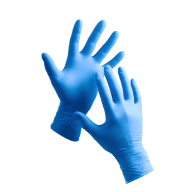Ulith® Safety Ice Defender Winter Gloves, Neon Orange/Black
Product description
The winter gloves offer optimum protection and comfort in cold working conditions. The ergonomic fit ensures precise handling and maximum freedom of movement for various activities. The combination of breathable material and non-slip design enables safe and comfortable working, even when worn for long periods.
Product features:
- Ergonomic fit for optimum wearing comfort
- Extremely non-slip design
- Breathable materials
- Suitable for winter use
Technical details:
- Material: Synthetic
- PSA VO (EU) 2016/425 CAT II
- VO (EU) 1935/2004
- EN 21420
- EN 388
- EN 511
- EN 13997
Identifies the material applied to the glove's exterior that enhances grip, chemical resistance, and durability while complementing the cut-resistant core material.
Defines how the glove secures at the wrist, affecting comfort, debris protection, and ease of donning/removal. Options vary in security and coverage.
Defines the surface texture on palms and fingers that enhances handling ability in various conditions, from smooth for precision to textured for wet environments.
Defines the inner material or construction that affects comfort, thermal properties, moisture management, and ease of donning/doffing during extended wear.
Indicates the knit density of the glove, affecting dexterity and protection level. Higher numbers offer better finger sensitivity for precision tasks.
Identifies the protective substances used in construction that determine cut resistance level, comfort, grip quality, and specialized protection properties.
Suited for diverse tasks, offering reliable cut protection without sacrificing dexterity. Balances safety and flexibility for various applications.
Offers complete hand coverage, including full finger protection from cuts and abrasions. A versatile style suitable for various tasks and environments.
- Cold Protective
- Slip Resistant
- Hand Protection
Request a free sample
Test first and buy later. Visit any product page to request your free sample.
Standards and labels
EN 13594:2015 is a European standard for testing and classification of fire resistance of smoke control systems. It sets out the requirements for test methods, performance criteria, and classification of fire resistance for smoke control systems such as smoke exhaust ducts, smoke dampers, and smoke control valves. The standard also includes requirements for test reports and the marking of products that have been tested and classified in accordance with the standard. The possible test results of EN 13594:2015 can range from non-compliant to Class A, B, C, D, E, F and G.
Test results
Impact Properties PThe EN 13594:2015 standard defines performance requirements for protective gloves for motorcycle riders, including testing for impact protection. Specifically, when a test result for 'Impact Properties' under this standard is denoted with a P, it signifies that the product, usually a protective glove, has passed the specified impact protection tests. This particular test examines a product's ability to dissipate energy or resist damage when subjected to impact forces, ensuring that the gloves will provide adequate protection to the wearer in the event of a crash or collision. During this test, a defined force is applied to different areas of the glove, usually using an impact test machine outfitted with a specified striker and anvil. The gloves are assessed based on their ability to absorb and redistribute the energy without transferring excessive force to the hand or failing structurally. A passing result indicates that the gloves meet the stringent requirements for impact resistance set by the European Standard, thereby providing adequate protection in high-risk motorcycle riding scenarios and reflecting a higher level of performance in safety gear for riders.
EN 388:2016 is a European standard for measuring the performance of protective gloves against mechanical risks (abrasion, cut, tear, and puncture). The standard includes test methods and performance requirements for gloves to be considered compliant. Test results are reported using a series of four numbers, each representing the performance level achieved in one of the tests.
Test results
Cut Resistance, Coup Test Level 1The EN 388:2016 standard is dedicated to gauging the mechanical risks for hand protection where a Cut Resistance, Coup Test Level 1 indicates minimal resistance to cutting because material achieved between 1.2 and 2.5 cycles before being cut through during the test. It means that the product tested at this level offers basic protection against shallow cuts, suitable for tasks with low risk of cut injuries. The test method used involves a rotating circular blade under a fixed force making contact with the fabric or material being tested. The blade moves back and forth across the material until a cut-through is achieved. The number of cycles required to cut through the sample at a consistent speed determines the cut resistance, with Level 1 being the second lowest rating after level 0. Products at this level are applicable in scenarios where there are minimal hazards from sharp objects, hence ideal for light duties where there is no significant risk of deep cuts.
Abrasion Resistance Level 2EN 388:2016 is an updated European standard that specifies criteria for testing gloves to protect against mechanical risks, including abrasion, cuts, tears, and puncture. The Abrasion Resistance Level 2 classification within this standard indicates a moderate level of protection against wear from rough materials. The abrasion resistance test involves subjecting the glove material to repeated cycles of sandpaper under pressure until the material wears through. Level 2 abrasion resistance means the gloves can withstand between 500 to 1999 cycles before being penetrated. This level of protection is suitable for tasks that involve handling or coming into contact with abrasive materials but not at an extreme or heavy-duty level. Gloves with Level 2 abrasion resistance are well-suited for general handling tasks, offering durability and protection to extend the life of the glove while maintaining good dexterity and comfort.
Tear Resistance Level 3EN 388:2016 is a European standard that specifies methods for testing the resistance of protective gloves against mechanical hazards, such as abrasion, cuts, punctures, and tearing. The Tear Resistance Level 3 indicates a high level of protection, where the gloves can withstand significant tearing forces. The test for determining tear resistance involves subjecting the glove material to a mechanical force until it tears, measuring the force required to initiate and continue the tear. For Level 3, gloves must withstand a force between 50 to 75 Newtons before tearing. This robust level of tear resistance is particularly suitable for demanding environments where gloves are exposed to activities that might cause extensive wear or tearing, such as handling heavy or rough materials, industrial assembly, and construction tasks. Gloves with this level of tear resistance provide enhanced durability and safety, reducing the risk of injuries and increasing the longevity of the glove in tough working conditions.
Puncture Resistance Level 1The European standard EN 388:2016 addresses the puncture resistance of protective gloves, with puncture resistance classified from Levels 1 to 4. Specifically, a Level 1 result indicates minimal puncture resistance. This level of resistance is determined by a test involving a standardized stylus with a specified diameter and force. During the test, the stylus is pressed against the material with a force up to 20 Newtons to assess how well the glove can withstand penetration. A Level 1 rating signifies that the glove provides basic protection against small punctures or stabs, appropriate for areas with minimal risk. Practical implications for this test result suggest the gloves are suitable for light tasks where major risks of punctures are not anticipated, but are not adequate for handling sharp tools or heavy equipment where higher penetration resistance would be necessary.
Cut Resistance, ISO 13997 Level BThe Cut Resistance test, ISO 13997, as per standard EN 388:2016, aims to gauge the resistance of protective glove materials against cuts by sharp objects. A test result of Level B means that the protective material can withstand forces between 5 and 10 Newtons before being penetrated. This implies moderate resistance, suitable for tasks like packaging, goods manufacturing, and warehousing. The ISO 13997 test involves using a TDM test device equipped with a straight-edge blade drawn once across the material in a defined direction until penetration occurs. The distance the blade travels before cutting through the material is recorded. This test, with its rigorous measurement of cutting force, is particularly useful for materials that tend to blunt blades, ensuring accurate and reliable performance ratings for gloves specifically meant for mechanical hazards. The practical implication for gloves rated at Level B is they offer moderate protection suitable for industries with moderate cut hazards, thus ensuring user safety in specific working environments like logistics or light manufacturing.
EN ISO 21420:2020 is a European standard that sets out the general requirements for hand protection, including comfort, fit, and dexterity.
Test results
General Requirements GuideEN 511:2006 is a European standard that sets requirements for the protection against cold for gloves and mittens. It covers factors such as resistance to cold, water penetration and breathability. Testing must be done by a certified lab and must show that the product meets all requirements of the standard. Possible test results would include pass/fail for each requirement, as well as specific measurement data.
Test results
Water Tightness Level XThe standard EN 511:2006 defines the requirements for protective gloves against cold. The reference to a Water Tightness Level X in this standard typically indicates that the glove has not been tested for water tightness. Water tightness is assessed through a specific test method where the gloves are subjected to water exposure under controlled conditions to check for leakage. The gloves are filled with water and then inspected visually to determine the presence of any water leakage. The practical implications of a Level X result for water tightness suggest that the gloves are either not designed to be waterproof or they failed to meet the minimum criteria for being labeled as water-resistant under normal usage conditions. This information is important for procurement professionals focusing specifically on the need for water-resistant or waterproof protective gloves.
Cold Contact Level XThe standard EN 511:2006 specifies the requirements and test methods for gloves designed to protect against convective and contact cold up to -50°C. The specific test result Cold Contact Level X indicates that the gloves have not been tested. The test assesses the thermal resistance of the glove material when exposed to cold objects. The test method involves measuring the temperature drop across the glove material when placed between two metal plates at different temperatures.
Convective Cold Level 1The standard EN 511:2006 specifies requirements and test methods for gloves designed to protect against cold environments, focusing on elements such as convective cold, contact cold, and water permeability. The Convective Cold test, particularly at Level 1, results in a performance level where the thermal insulation (denoted as TR) measured in \(m^2°C/W\) is in the range of 0.10 to less than 0.15. This measurement indicates the glove's ability to provide minimal thermal resistance against cold air. The Convective Cold Test involves placing a glove on an electrically heated hand model, where the power required to maintain the hand at a set temperature (typically around 30°C) in a controlled cooling environment is measured. The glove's performance level is determined based on how much power is needed to keep the hand warm as the surrounding temperature decreases. Level 1 highlights a basic level of insulation against cold air, suitable for environments where slight cold protection is sufficient, but would not be suitable for more severe cold conditions. .
EN ISO 21420:2020 is a European standard that sets out the general requirements for hand protection, including comfort, fit, and dexterity.
Test results
General Requirements GuideCE Marking is a label that shows a product meets certain safety and environmental standards set by the European Union. To get the CE Marking, a company must test and certify their product meets these standards. CE Marking is required for many products sold in the EU, including electronics, machinery, toys and medical devices. It helps ensure that products are safe for consumers and the environment, and allows for easy trade within the EU.
PPE stands for "personal protective equipment." PPE Category 3 refers to equipment that is complex and provide the highest level of protection such as powered respirators, SCBA, and full body suits. In Europe, PPE Category 3 must meet certain safety standards set by the European Union, which means that it must be designed and manufactured to protect the user without causing harm. Companies that make or sell PPE must prove that it meets these standards. They also must have a quality management system in place, have to be audited regularly by a notified body and have to have a technical documentation.
F W Burmann delivery terms
Free delivery for all F W Burmann products
143,65 €
Price per 12 packages (72 pairs)
2,00 € / pair
Shipping fee is 6,68 € for orders under 150,00 €
A carton contains 12 packages (72 pairs)
Need larger quantities?
Other products you may like
Recently viewed
Need help?
Get help from our experts
Other products you may like
Similar products you may like
Recommended for you
F W Burmann
Delivery time: 3 business days
Orders from 500,00 €
Supplier shipping fee 6,68 €
Free shipping on orders over 150,00 €



Find +150,000 products from hundreds of brands
Autonomous sourcing platform
The most efficient way to source and order supplies for your operations
Sourcing
Ordering
List products you’re looking for and we’ll find the best products and prices for you – all for free.
Need help?
Get help from our experts



